Space Shuttle

Space Shuttle

| Function | Crewed orbital launch and reentry |
|---|---|
| Manufacturer | United Space AllianceThiokol/Alliant Techsystems(SRBs)Lockheed Martin/Martin Marietta(ET)Boeing/Rockwell(orbiter) |
| Country of origin | United States |
| Project cost | US$209 billion (2010)[2][3][4] |
| Cost per launch | US$450 million (2011)[5]to 1.5 billion (2011)[3][4][6][7] |
| Size | |
| Height | 56.1 m (184 ft 1 in) |
| Diameter | 8.7 m (28 ft 7 in) |
| Mass | 2,030,000 kg (4,470,000 lb) |
| Stages | 2 |
| Capacity | |
| Payload toLEO | 27,500 kg (60,600 lb) |
| Payload toISS | 16,050 kg (35,380 lb) |
| Payload toGTO | 3,810 kg (8,400 lb) |
| Payload toPolar orbit | 12,700 kg (28,000 lb) |
| Payload to Earth return | 14,400 kg (31,700 lb)[8] |
| Launch history | |
| Status | Retired |
| Launch sites | LC-39,Kennedy Space CenterSLC-6,Vandenberg AFB(unused) |
| Total launches | 135 |
| Successes | 134 launches and 133 landings |
| Failures | 2Challenger(launch failure, 7 fatalities),Columbia(re-entry failure, 7 fatalities) |
| First flight | April 12, 1981 |
| Last flight | July 21, 2011 |
| Notable payloads | Tracking and Data Relay SatellitesSpacelabHubble Space TelescopeGalileo,Magellan,UlyssesCompton Gamma Ray ObservatoryMir Docking ModuleChandra X-ray ObservatoryISS components |
| Boosters –Solid Rocket Boosters | |
| Engines | 2solid |
| Thrust | 12,500 kN (2,800,000 lbf) each, sea level liftoff |
| Specific impulse | 269 seconds (2.64 km/s) |
| Burn time | 124 s |
| Fuel | Solid (Ammonium perchlorate composite propellant) |
| First stage –OrbiterplusExternal Tank | |
| Engines | 3SSMEslocated on Orbiter |
| Thrust | 5,250 kN (1,180,000 lbf) total, sea level liftoff[9] |
| Specific impulse | 455 seconds (4.46 km/s) |
| Burn time | 480 s |
| Fuel | LOX/LH2 |
| Boosters | |
| No. boosters | 2 |
The Space Shuttle was a partially reusable low Earth orbital spacecraft system that was operated from 1981 to 2011 by the U.S. National Aeronautics and Space Administration (NASA) as part of the Space Shuttle program. Its official program name was Space Transportation System (STS), taken from a 1969 plan for a system of reusable spacecraft of which it was the only item funded for development.[10] The first of four orbital test flights occurred in 1981, leading to operational flights beginning in 1982. In addition to the prototype whose completion was cancelled, five complete Shuttle systems were built and used on a total of 135 missions from 1981 to 2011, launched from the Kennedy Space Center (KSC) in Florida. Operational missions launched numerous satellites, interplanetary probes, and the Hubble Space Telescope (HST); conducted science experiments in orbit; and participated in construction and servicing of the International Space Station. The Shuttle fleet's total mission time was 1322 days, 19 hours, 21 minutes and 23 seconds.[11]
Shuttle components include the Orbiter Vehicle (OV) with three clustered Rocketdyne RS-25 main engines, a pair of recoverable solid rocket boosters (SRBs), and the expendable external tank (ET) containing liquid hydrogen and liquid oxygen. The Space Shuttle was launched vertically, like a conventional rocket, with the two SRBs operating in parallel with the OV's three main engines, which were fueled from the ET. The SRBs were jettisoned before the vehicle reached orbit, and the ET was jettisoned just before orbit insertion, which used the orbiter's two Orbital Maneuvering System (OMS) engines. At the conclusion of the mission, the orbiter fired its OMS to deorbit and reenter the atmosphere. The orbiter then glided as a spaceplane to a runway landing, usually to the Shuttle Landing Facility at Kennedy Space Center, Florida or Rogers Dry Lake in Edwards Air Force Base, California. After landing at Edwards, the orbiter was flown back to the KSC on the Shuttle Carrier Aircraft, a specially modified Boeing 747.
The first orbiter, Enterprise, was built in 1976, used in Approach and Landing Tests and has no orbital capability. Four fully operational orbiters were initially built: Columbia, Challenger, Discovery, and Atlantis. Of these, two were lost in mission accidents: Challenger in 1986Columbia in 2003in 2003]] Endeavour Soyuz spacecraft Commercial Crew Development Space Launch System programs on schedule for first flights in 2019 and 2020.
| Function | Crewed orbital launch and reentry |
|---|---|
| Manufacturer | United Space AllianceThiokol/Alliant Techsystems(SRBs)Lockheed Martin/Martin Marietta(ET)Boeing/Rockwell(orbiter) |
| Country of origin | United States |
| Project cost | US$209 billion (2010)[2][3][4] |
| Cost per launch | US$450 million (2011)[5]to 1.5 billion (2011)[3][4][6][7] |
| Size | |
| Height | 56.1 m (184 ft 1 in) |
| Diameter | 8.7 m (28 ft 7 in) |
| Mass | 2,030,000 kg (4,470,000 lb) |
| Stages | 2 |
| Capacity | |
| Payload toLEO | 27,500 kg (60,600 lb) |
| Payload toISS | 16,050 kg (35,380 lb) |
| Payload toGTO | 3,810 kg (8,400 lb) |
| Payload toPolar orbit | 12,700 kg (28,000 lb) |
| Payload to Earth return | 14,400 kg (31,700 lb)[8] |
| Launch history | |
| Status | Retired |
| Launch sites | LC-39,Kennedy Space CenterSLC-6,Vandenberg AFB(unused) |
| Total launches | 135 |
| Successes | 134 launches and 133 landings |
| Failures | 2Challenger(launch failure, 7 fatalities),Columbia(re-entry failure, 7 fatalities) |
| First flight | April 12, 1981 |
| Last flight | July 21, 2011 |
| Notable payloads | Tracking and Data Relay SatellitesSpacelabHubble Space TelescopeGalileo,Magellan,UlyssesCompton Gamma Ray ObservatoryMir Docking ModuleChandra X-ray ObservatoryISS components |
| Boosters –Solid Rocket Boosters | |
| Engines | 2solid |
| Thrust | 12,500 kN (2,800,000 lbf) each, sea level liftoff |
| Specific impulse | 269 seconds (2.64 km/s) |
| Burn time | 124 s |
| Fuel | Solid (Ammonium perchlorate composite propellant) |
| First stage –OrbiterplusExternal Tank | |
| Engines | 3SSMEslocated on Orbiter |
| Thrust | 5,250 kN (1,180,000 lbf) total, sea level liftoff[9] |
| Specific impulse | 455 seconds (4.46 km/s) |
| Burn time | 480 s |
| Fuel | LOX/LH2 |
| Boosters | |
| No. boosters | 2 |
Design and development
Historical background
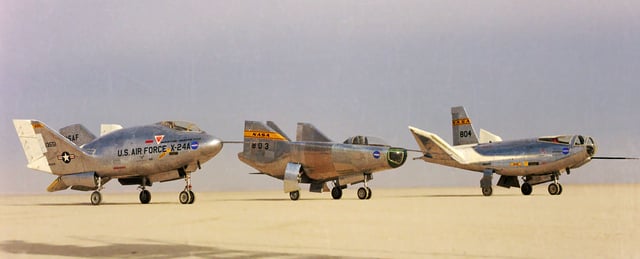
The X-24A, M2-F3, and HL-10 lifting bodies
During the 1950s, the United States Air Force proposed using a reusable piloted glider to perform military operations such as reconnaissance, satellite attack, and employing air-to-ground weapons.
In the late-1950s, the Air Force began developing the partially reusable X-20 Dyna-Soar. The Air Force collaborated with NASA on the Dyna-Soar, and began training 6 pilots in June 1961. The rising costs of development and the prioritization of Project Gemini led to the cancellation of the Dyna-Soar program in December 1963. In addition to the Dyna-Soar, the Air Force conducted a study in 1957 to test the feasibility of reusable boosters. This became the basis for the Aerospaceplane, a fully reusable spacecraft that was never developed beyond the initial design phase in 1962–1963.[12]
Beginning in the early 1950s, NASA and the Air Force collaborated on developing lifting bodies to test aircraft that primarily generated lift from their fuselages instead of wings, and tested the M2-F1, M2-F2, M2-F3, HL-10, X-24A, and the X-24B. The program tested aerodynamic characteristics that would later be applied to the Space Shuttle, including unpowered landing from a high altitude and speed.[13][14]
Design process

President Nixon (right) with NASA Administrator James Fletcher in January 1972
In September 1966, NASA and the Air Force released a joint study concluding that a new vehicle was required to satisfy their respective future demands, and that a partially reusable system would be the most cost-effective solution.[12] The head of the NASA Office of Manned Space Flight, George Mueller, announced the plan for a reusable shuttle on August 10, 1968. NASA issued a Request for Proposal (RFP) for designs of the Integrated Launch and Re-entry Vehicle (ILRV), which would later become the Space Shuttle. Rather than award a contract based upon initial proposals, NASA announced a phased approach for the Space Shuttle contracting and development; Phase A was a request for studies completed by competing aerospace companies, Phase B was a competition between two contractors for a specific contract, Phase C involved designing the details of the spacecraft components, and Phase D was the production of the spacecraft.[15][14]
In December 1968, NASA created the Space Shuttle Task Group to determine the optimal design for a reusable spacecraft, and issued study contracts to General Dynamics, Lockheed, McDonnell Douglas, and North American Rockwell. In July 1969, the Space Shuttle Task Group issued a report that determined that the Shuttle would be required to support a space station, launch, service, and retrieve satellites, and support short-duration crewed missions. The report also created three classes of a future reusable shuttle: Class I would have a reusable orbiter mounted on expendable boosters, Class II would use stage-and-a-half staging, and Class III would have both a reusable orbiter and booster. In September 1969, the Space Task Group, under leadership of Vice President Spiro Agnew, issued a report calling for the development of a space shuttle to bring people and cargo to low Earth orbit (LEO), as well as a space tug for transfers between orbits and the Moon, and a reusable nuclear stage for deep space travel.[12] [10]
After the release of the Space Shuttle Task Group report, many aerospace engineers favored the Class III, fully reusable design because of perceived savings in hardware costs.
Max Faget, a NASA engineer who had worked to design the Mercury capsule, patented a design for a two-stage fully recoverable system with a straight-winged orbiter mounted on a larger straight-winged booster.[16][17] The Air Force Flight Dynamics Laboratory argued that a straight-wing design would not be able to withstand the high thermal and aerodynamic stresses during reentry, and would not provide the required cross-range capability. Additionally, the Air Force required a larger payload capacity than Faget's design allowed. In January 1971, NASA and Air Force leadership decided that a reusable delta-wing orbiter mounted on an expendable propellant tank would be the optimal design for the Space Shuttle.[12]
After establishing the need for a reusable, heavy-lift spacecraft, NASA and the Air Force began determining the design requirements of their respective services.
The Air Force expected to launch large satellites into a polar orbit, and that the Space Shuttle have a 15 by 60 foot payload bay, 1,100 mile cross-range, and the capacity to lift 65,000 pounds to an easterly low Earth orbit, and 40,000 pounds into polar orbit. NASA evaluated the F-1 and J-2 engines from the Saturn rockets, and determined that they were insufficient for the requirements of the Space Shuttle, and in July 1971, it issued a contract to Rocketdyne to begin development on the RS-25 engine.[12]
NASA reviewed 29 potential designs for the Space Shuttle.
NASA determined that a design with two side boosters should be used, and the boosters should be reusable to reduce costs.
NASA and the Air Force elected to use solid-propellant boosters because of the lower costs and the ease of refurbishing them for reuse after they landed in the ocean. In January 1972, President Richard Nixon approved the Shuttle, and NASA decided on its final design in March. In August 1972, NASA awarded the contract to build the orbiter to North American Rockwell, the solid-rocket booster contract to Morton Thiokol, and the external tank contract to Martin Marietta.[12]
Development

Columbia undergoing installation of its ceramic tiles
On June 4, 1974, Rockwell began construction on the first shuttle, Orbiter Vehicle (OV)-101, which would later be named Enterprise*]]** erprisewas designed as a test vehicle, and did not include engines or heat shielding. Construction was completed on September 17, 1976, and Enterprise* was moved to Edwards AFB to begin testing.[12] [18] Rockwell also constructed the Main Propulsion Test Article (MPTA)-098, which was later fit with RS-25 engines and tested at the National Space Technology Laboratory (NSTL). Rockwell conducted structural tests on Structural Test Article (STA)-099 to determine the effect of aerodynamic stresses.[14]
The beginning of the development of the RS-25 Space Shuttle Main Engine was delayed for nine months while Pratt & Whitney challenged the contract that had been issued to Rocketdyne. The first engine was completed in March 1975, after issues with developing the first throttlable, reusable engine. During engine testing, the RS-25 experienced multiple nozzle failures, as well as broken turbine blades. Despite the problems during testing, NASA ordered the nine RS-25 engines needed for its three orbiters under construction in May 1978.[12]
NASA experienced significant delays in the development of the Space Shuttle's thermal protection system. Previous NASA spacecraft had used ablative heat shields, but those could not be reused. NASA chose to use ceramic tiles for thermal protection, as the shuttle could then be constructed of lightweight aluminum, and the tiles could be individually replaced as needed. Construction began on Columbia*]]n March 27, 1975, and it was delivered to the Kennedy Space Center (KSC) on March 25, 1979. At the time of its arrival at the KSC, umbiastill had 6,000 of its 30,000 tiles remaining to be installed. However, many of the tiles that had been originally installed had to be replaced, requiring two years of installation before Columbia* could fly.[12] [14]
On January 5, 1979, NASA commissioned a second orbiter.
Later that month, Rockwell began converting STA-099 to OV-099, later named ChallengerDiscoveryAtlantisEndeavour[14]
Testing
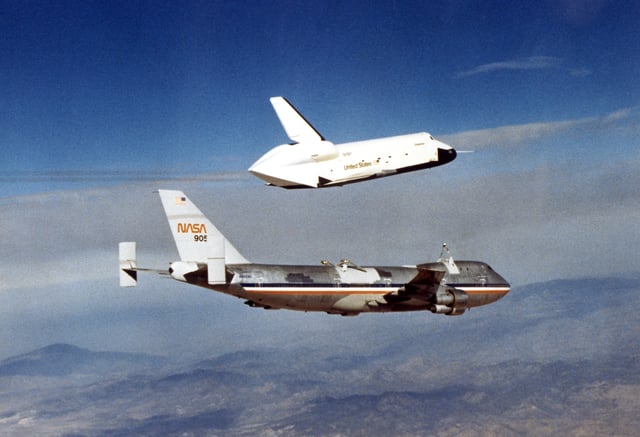
Enterprise during the Approach and Landing Tests

Columbia launching on STS-1[1]
After it arrived at Edwards AFB, Enterprise underwent flight testing with the Shuttle Carrier Aircraft, a Boeing 747 that was modified to carry the orbiter. In February 1977, Enterprise began the Approach and Landing Tests and underwent captive flights, where it remained attached to the Shuttle Carrier Aircraft for the duration of the flight. On August 12, 1977, Enterprise conducted its first glide test, where it detached from the Shuttle Carrier Aircraft and landed at Edwards AFB.[12] After four additional flights, Enterprise was moved to the Marshall Space Flight Center on March 13, 1978. Enterprise underwent shake tests in the Mated Vertical Ground Vibration Test, where it was attached to an external tank and solid rocket boosters, and underwent vibrations to simulate the stresses of launch. In April 1979, Enterprise was taken to the Kennedy Space Center, where it was attached to an external tank and solid rocket boosters, and moved to LC-39. Once installed at the launch pad, the Space Shuttle was used to verify the proper positioning of launch complex hardware. Enterprise was taken back to California in August 1979, and later served in the development of the SLC-6 at Vandenberg AFB in 1984.[14]
On November 26, 1980, Columbia was mated with its external tank and solid-rocket boosters, and was moved to LC-39 on December 29, 1980. The first Space Shuttle mission, STS-1, would be the first time NASA performed a crewed first-flight of a spacecraft. On April 12, 1981, the Space Shuttle launched for the first time, and was piloted by John Young and Robert Crippen. During the two-day mission, Young and Crippen tested equipment on board the shuttle, and found several of the ceramic tiles had fallen off the top side of the Columbia. NASA coordinated with the Air Force to use satellites to image the underside of Columbia, and determined there was no damage. Columbia reentered the atmosphere on April 14, and landed at Edwards AFB.[14] [12]
NASA conducted three additional test flights with Columbia in 1981 and 1982. On July 4, 1982, STS-4, flown by Ken Mattingly and Henry Hartsfield, landed at Edwards AFB. President Ronald Reagan and his wife Nancy met the crew, and delivered a speech. After STS-4, NASA declared the Space Shuttle operational.[12]
Description
The Space Shuttle was the first operational orbital spacecraft designed for reuse. Each Space Shuttle orbiter was designed for a projected lifespan of 100 launches or ten years of operational life, although this was later extended.[19] At launch, it consisted of the orbiter, which contained the crew and payload, the external tank (ET), and the two solid rocket boosters (SRBs).[20][21]
Responsibility for the Shuttle components was spread among multiple NASA field centers.
The Kennedy Space Center was responsible for launch, landing and turnaround operations for equatorial orbits (the only orbit profile actually used in the program), the U.S.
Air Force at the Vandenberg Air Force Base was responsible for launch, landing and turnaround operations for polar orbits (though this was never used), the Johnson Space Center served as the central point for all Shuttle operations, the Marshall Space Flight Center was responsible for the main engines, external tank, and solid rocket boosters, the John C. Stennis Space Center handled main engine testing, and the Goddard Space Flight Center managed the global tracking network.[22]
Orbiter
The orbiter had design elements and capabilities of both a rocket and aircraft to allow it to launch vertically and then land as a glider.
Its three-part fuselage provided support for the crew compartment, cargo bay, flight surfaces, and engines.
The rear of the orbiter contained the Space Shuttle Main Engines (SSME), which provided thrust during launch, as well as the Orbital Maneuvering System (OMS), which allowed the orbiter to achieve, alter, and exit its orbit once in space.
Its double-delta wings were 60 feet long, and were swept 81° at the inner leading edge and 45° at the outer leading edge. Each wing had an inboard and outboard elevon to provide flight control during reentry, along to a flap located below the engine to control pitch. The orbiter's vertical stabilizer was swept backwards at 45°, and contained a rudder that could split to act as a speed brake. The vertical stabilizer also contained a two-part drag parachute system to slow the orbiter after landing. The orbiter used a retractable landing gear with a nose landing gear and two main landing gears, each containing two tires. The main landing gears contained two brake assemblies each, and the nose landing gear contained an electro-hydraulic steering mechanism.[14] [23]
Four operational OVs were originally built.
Following the construction of Columbia (OV-102) and the conversion of Challenger (OV-099) to a flyable spacecraft, Discovery (OV-103) and Atlantis (OV-104) were ordered in January 1979. After the Challenger disaster in January 1986, NASA ordered a fifth OV, Endeavour (OV-105) in July 1987. Endeavour was primarily built from structural spares that were created during the construction of Discovery and Atlantis.[24][25][26][23]
Crew compartment
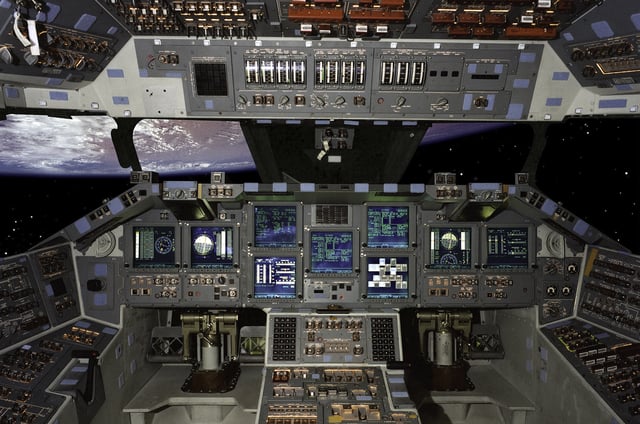
Atlantis was the first Shuttle to fly with a glass cockpit on STS-101.
The crew compartment comprised three decks, and was the pressurized, habitable area on all Space Shuttle missions.
The cockpit consists of two seats for the commander and pilot, as well as an additional two to four seats for crew members.
The mid-deck is located below the cockpit, and is where the galley and crew bunks are set up, as well as three or four crew member seats.
The mid-deck contained the airlock, which could support two astronauts on an extravehicular activity (EVA), as well as access to pressurized research modules. An equipment bay was below the mid-deck, which stored environmental control and waste management systems.[14] [23] To ensure the cabin would be comfortable for the crew, designers created a full-sized cardboard mock-up of the cabin. Astronauts would then mimic their daily activities inside of the mock-up. Each time they knocked up against a corner, technicians would remove the part of the mock-up that had gotten in the astronauts' way until there were no more collisions and the cabin was deemed to be comfortable.[27]
On the first four Shuttle missions, astronauts wore modified U.S.
Air Force high-altitude full-pressure suits, which included a full-pressure helmet during ascent and descent.
From the fifth flight, STS-5, until the loss of Challenger, the crew wore one-piece light blue nomex flight suits and partial-pressure helmets. After the Challenger disaster, the crew members wore the Launch Entry Suit (LES), a partial-pressure version of the high-altitude pressure suits with a helmet. In 1994, the LES was replaced by the full-pressure Advanced Crew Escape Suit (ACES), which was a full-pressure suit that improved the safety of the astronauts in an emergency situation. Columbia originally had modified SR-71 zero-zero ejection seats installed for the ALT and first four missions, but these were disabled after STS-4 and removed after STS-9.[23]
The flight deck was the top level of the crew compartment, and contained the flight controls for the orbiter.
The commander sat in the front left seat, and the pilot sat in the front right seat, with two to four additional seats set up for additional crew members.
The instrument panels contained over 2,100 displays and controls, and the commander and pilot were both equipped with a heads-up display (HUD) and a Rotational Hand Controller (RHC) to gimbal the engines during powered flight and fly the orbiter during unpowered flight. Both seats also had rudder controls, to allow rudder movement in flight and nose-wheel steering on the ground. The orbiter vehicles were originally installed with the Multifunction CRT Display System (MCDS) to display and control flight information. The MCDS displayed the flight information at the commander and pilot seats, as well as at the after seating location, and also controlled the data on the HUD. In 1998, Atlantis was upgraded with the Multifunction Electronic Display System (MEDS), which was a glass cockpit upgrade to the flight instruments that replaced the eight MCDS display units with 11 multifunction colored digital screens. MEDS was flown for the first time in May 2000 on STS-98, and the other orbiter vehicles were upgraded to it. The aft section of the flight decked contained windows looking into the payload bay, as well as an RHC to control the Remote Manipulator System during cargo operations. Additionally, the aft flight deck had monitors for a closed-circuit television to view the cargo bay.[23]
The mid-deck was located underneath the flight deck.
It contained the crew equipment storage, as well as the sleeping and hygiene stations for the crew.
The mid-deck contained seats for three crewmembers (*Columbia'*s mid-deck could seat four) during launch and landing procedures. The mid-deck contained a port-side hatch that crew used for entry and exit while on Earth. Additionally, each orbiter was originally installed with an internal airlock in the mid-deck. The airlock was replaced with an external airlock on Discovery, Atlantis, and Endeavour to improve docking with Mir and the ISS.[23]
Flight systems
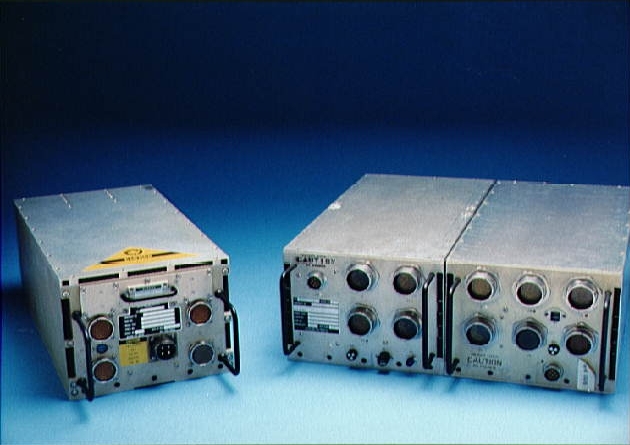
The AP-101S (left) and the AP-101B (right)
The orbiter was equipped with an avionics system to provide information and control during atmospheric flight. Its avionics suite contained three microwave scanning beam landing systems, three gyroscopes, three TACANs, three accelerometers, two radar altimeters, two barometric altimeters, three attitude indicators, two Mach indicators, and two Mode C transponders. During reentry, the crew deployed two air data probes once they were travelling slower than Mach 5. The orbiter had three inertial measuring units (IMU) that it used for guidance and navigation during all phases of flight. The orbiter contains two star trackers to align the IMUs while in orbit. The star trackers are deployed while in orbit, and can automatically or manually align on a star. In 1991, NASA began upgrading the inertial measurement units with an inertial navigation system (INS), which provided more accurate location information. In 1993, NASA flew a GPS receiver for the first time aboard STS-51. In 1997, Honeywell began developing an integrated GPS/INS to replace the IMU, INS, and TACAN systems, which first flew on STS-118 in August 2007[23] [28][29]
While in orbit, the crew primarily communicated using one of four S band radios, which provided both voice and data communications. Two of the S band radios were phase modulation transceivers, and could transmit and receive information. The other two S band radios were frequency modulation transmitters, and were used to transmit data to NASA. As S band radios can only operate within their line of sight, NASA used the Tracking and Data Relay Satellite System and the Spacecraft Tracking and Data Acquisition Network ground stations to communicate with the orbiter throughout its orbit. Additionally, the orbiter deployed a high-bandwidth Ku band radio out of the cargo bay. The Ku radio could also utilized as a rendezvous radar. The orbiter was also equipped with two UHF radios for communications with air traffic control and astronauts conducting extravehicular activity.[23]
Although the orbiter could not be flown without a crew, its fly-by-wire control system was entirely reliant on its main computer, the Data Processing System (DPS). The DPS controlled the flight controls and thrusters on the orbiter vehicle, as well as the ET and SRBs during launch. The DPS consisted of five general purpose computers (GPC), two magnetic tape mass memory units (MMUs), and the associated sensors to monitors the Space Shuttle components. The original GPC used was the IBM AP-101B, which used a separate central processing unit (CPU) and inputer/output processor (IOP), and non-volatile solid-state memory. From 1991 to 1993, the orbiter vehicles were upgraded to the AP-101S, which improved the memory and processing capabilities, and reduced the volume and weight of the computers by combining the CPU and IOP into a single unit. Four of the GPCs were loaded with the Primary Avionics Software System (PASS), which was Space Shuttle-specific software that provided control through all phases of flight. During ascent, maneuvring, reentry, and landing, the four PASS GPCs functioned identically to produce quadruple redundancy, and would error check their results. In case of a software error that would cause erroneous reports from the four PASS GPCs, a fifth GPC ran the Backup Flight System, which used a different program and could control the Space Shuttle through ascent, orbit, and reentry, but could not support an entire mission. The five GPCs were separated in three separate bays within the mid-deck to provide redundancy in the event of a cooling fan failure. After achieving orbit, the crew would switch some of the GPCs functions from guidance, navigation, and control (GNC) to systems management (SM) and payload (PL) to support the operational mission.[23] [30][31]
Space Shuttle missions typically brought a portable general support computer (PGSC) that could integrate with the orbiter vehicle's computers and communication suite, as well as monitor scientific and payload data.
Early missions brought the Grid Compass, one of the first laptop computers, as the PGSC, but later missions brought Apple and Intel laptops.[23] [32]
Cargo bay
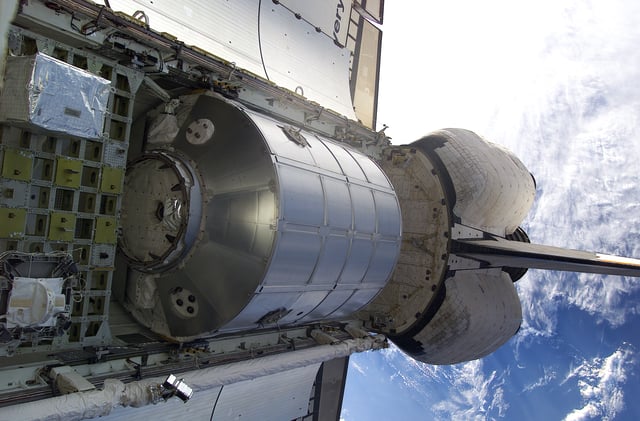
MPLM Leonardo

The Galileo spacecraft deploying during STS-34
The orbiter's 60-foot (18 m)-long payload bay, comprising most of the fuselage, could accommodate cylindrical payloads up to 15 feet (4.6 m) in diameter. Information declassified in 2011 showed that these measurements were chosen specifically to accommodate the KH-9 HEXAGON spy satellite operated by the National Reconnaissance Office.[33] Two mostly symmetrical lengthwise payload bay doors hinged on either side of the bay comprised its entire top. Payloads were generally loaded horizontally into the bay while the orbiter was standing upright on the launch pad and unloaded vertically in the near-weightless orbital environment by the orbiter's robotic remote manipulator arm (under astronaut control), EVA astronauts, or under the payloads' own power (as for satellites attached to a rocket "upper stage" for deployment.) Additionally, the shuttle performed the capture and return of large payloads back to Earth. The typical payload capacity was about 50,045 pounds (22,700 kg) but could be increased depending on the choice of launch configuration.
The orbiter could be used in conjunction with a variety of add-on components depending on the mission.
This included orbital laboratories (Spacelab, Spacehab), boosters for launching payloads farther into space (Inertial Upper Stage, Payload Assist Module), and other functions, such as provided by Extended Duration Orbiter, Multi-Purpose Logistics Modules, or Canadarm (RMS). An upper stage called Transfer Orbit Stage (Orbital Science Corp. TOS-21) was also used once with the orbiter.[34] Other types of systems and racks were part of the modular Spacelab system —pallets, igloo, IPS, etc., which also supported special missions such as SRTM.[35] To extend the duration that orbiters could stay docked at the ISS, the Station-to-Shuttle Power Transfer System (SSPTS) was installed. The SSPTS allowed these orbiters to use power provided by the ISS to preserve their consumables. The SSPTS was first used successfully on STS-118.[36][37]
Remote Manipulator System
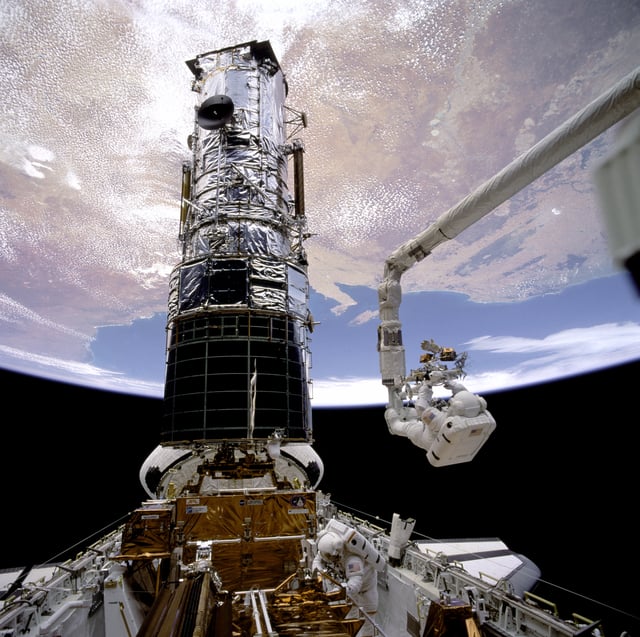
Story Musgrave attached to the RMS servicing the Hubble Space Telescope during STS-61
The Remote Manipulator System (RMS), also known as Canadarm, was a mechanical arm attached to the cargo bay.
It could be used to grasp and manipulate payloads, as well as serve as a mobile platform for astronauts conducting an Extravehicular activity (EVA). The RMS was built by the Canadian company Spar Aerospace, and was controlled by an astronaut inside the orbiter's flight deck using their windows and closed-circuit television. The RMS allowed for six-degrees of freedom, and had six joints located at 3 points along the arm.[14]
Spacelab

Spacelab in orbit on STS-9
In 1973, European ministers met in Belgium to authorize Western Europe's crewed orbital project and its main contribution to Space Shuttle—the Spacelab program.[38] Spacelab would provide a multidisciplinary orbital space laboratory and additional space equipment for the Shuttle.[38][35] Supported by a modular system of pressurized modules, pallets, and systems, Spacelab missions executed on multidisciplinary science, orbital logistics, and international cooperation.[35] Over 29 missions flew on subjects including astronomy, microgravity, radar, and life sciences.[35] Spacelab hardware also supported missions such as Hubble Space Telescope (HST) servicing and space station resupply.[35] STS-2 and STS-3 provided testing, and the first full mission was Spacelab-1 (STS-9) launched on November 28, 1983.[35] Germany funded the Spacelab missions D1 and D2.[39][40][41][42][43] In addition to the European Space Agency, Japan also partially funded research during the SL-J mission.[44]
Space Shuttle Main Engines
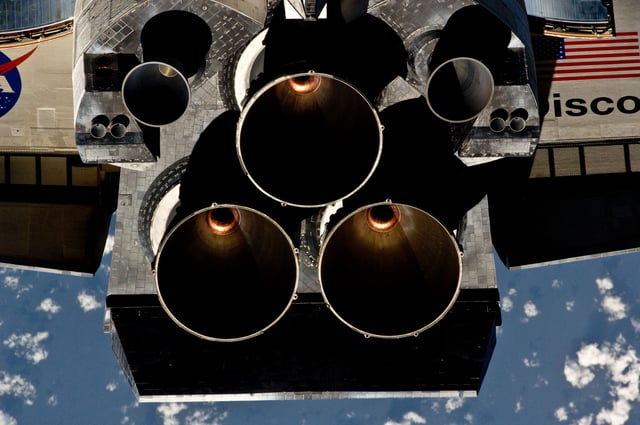
The Space Shuttle Main Engine with the two Orbital Maneuvering System (OMS) pods.
Three Space Shuttle Main Engines (SSMEs) were mounted on the orbiter's aft fuselage in a triangular pattern.
The engine nozzles could gimbal 10.5 degrees up and down, and 8.5 degrees from side to side during ascent to change the direction of their thrust to steer the Shuttle. The orbiter structure was made primarily from aluminum alloy, although the engine structure was made primarily from titanium alloy.
The Space Shuttle Main Engines (SSMEs) had several improvements to enhance reliability and power.
During the development program, Rocketdyne determined that the engine was capable of safe reliable operation at 104% of the originally specified thrust. To keep the engine thrust values consistent with previous documentation and software, NASA kept the original specified thrust as 100%, but had the SSME operate at higher thrust. SSME upgrade versions were denoted as block I and block II. 109% thrust level was achieved with the Block II engines in 2001. The normal maximum throttle was 104 percent, with 106% or 109% used for mission aborts.[14]
Orbital Maneuvering System
The Orbital Maneuvering System (OMS) consisted of two aft-mounted AJ10-190 engines and the associated fuel pods. The AJ10 engines used monomethylhydrazine (MMH) as a monopropellant oxidized by dinitrogen tetroxide (N2O4).[45] The pods carried a maximum of 8,174 kilograms (18,021 lb) of MMH and 13,486 kilograms (29,732 lb) of N2O4.[46] The OMS engines were used after main engine cut-off (MECO) for orbital insertion. Throughout the flight, they were used for orbit changes, as well as the deorbit burn prior to reentry.[47]
Thermal Protection System
The orbiter was protected from heat during rentry by the Thermal Protection System (TPS), a thermal soaking protective layer around the orbiter. In contrast with previous US spacecraft, which had used ablative heat shields, the reusability of the orbiter required a multi-use heat shield.[14]
External tank
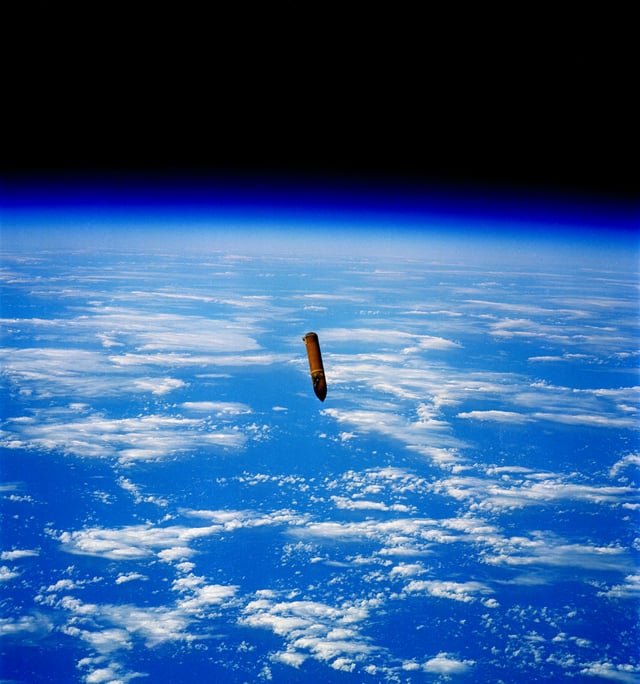
The external tank after separation on STS-29.
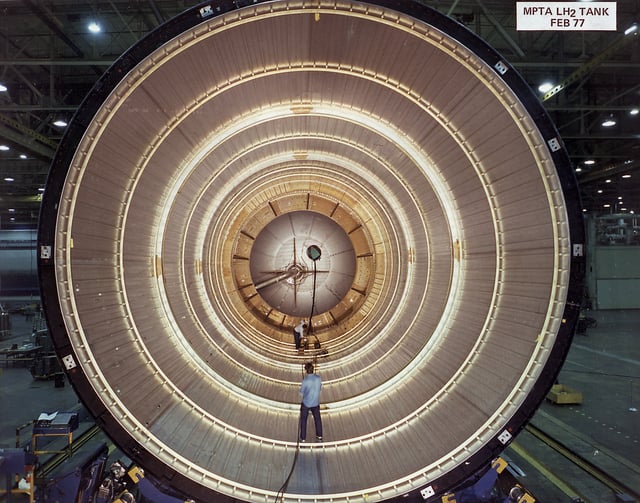
Interior of an External Tank
The main function of the Space Shuttle external tank was to supply the liquid oxygen and hydrogen fuel to the main engines.
It was also the backbone of the launch vehicle, providing attachment points for the two solid rocket boosters and the orbiter.
The external tank was the only part of the Shuttle system that was not reused.
Although the external tanks were always discarded, it would have been possible to take them into orbit and re-use them (such as a wet workshop for incorporation into a space station).[48][49]
For the first two missions, STS-1 and STS-2, the external tank was painted white to protect the insulation that covers much of the tank, but improvements and testing showed that it was not required. The weight saved by not painting the tank resulted in an increase in payload capability to orbit.[50] Additional weight was saved by removing some of the internal "stringers" in the hydrogen tank that proved unnecessary. The resulting "light-weight external tank" was first flown on STS-6 [51] and used on the majority of Shuttle missions. STS-91 saw the first flight of the "super light-weight external tank". This version of the tank was made of the 2195 aluminum-lithium alloy. It weighed 3.4 metric tons (7,500 lb) less than the last run of lightweight tanks, allowing the Shuttle to deliver heavy elements to ISS's high inclination orbit.[51]
Solid rocket boosters
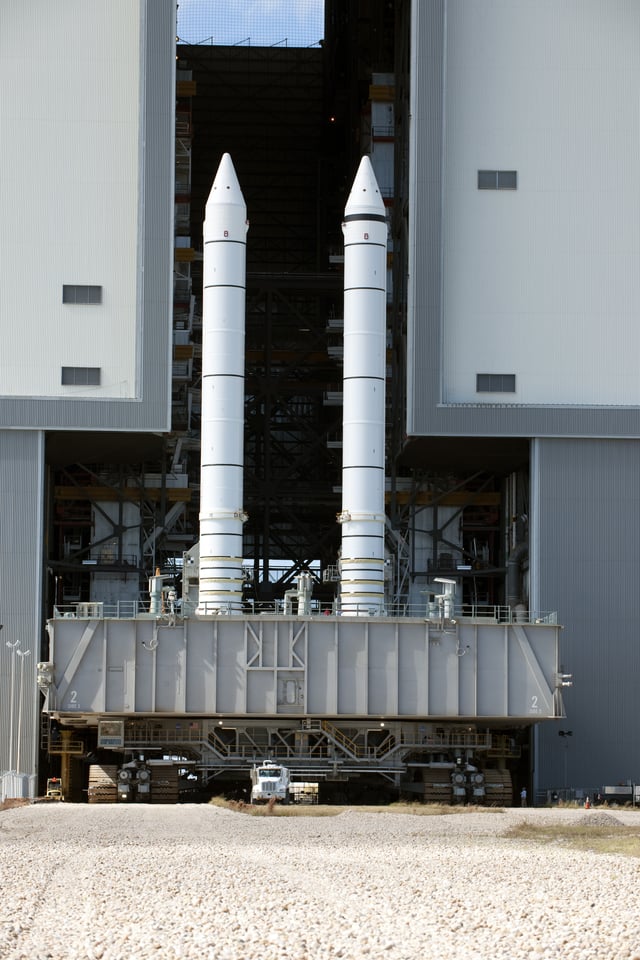
Two SRBs on the crawler prior to mating with the Shuttle
At launch, the external tank was connected to two solid rocket boosters (SRBs) that provided over 70% of the Space Shuttle's thrust.
They were the largest solid rocket motors ever flown, and the first solid rocket motors used on a crewed spacecraft.[52] Each SRBs was 45 m (149 ft) tall and 3.7 m (12 ft) wide, weighed 68,000 kg (150,000 lb), and had a steel exterior approximately 13 mm (.5 in) thick.[53] The SRB contained four sections that comprised the solid rocket motor, a nose cone, and the rocket nozzle. The four sections of the rocket motor were filled with a total 1.25 million pounds of solid rocket propellant, and joined together at the Vehicle Assembly Building at the Kennedy Space Center. For the first two minutes of flight, they each provided 13,300 kN (3,000,000 lbf) of thrust.[54] After expending their fuel, the SRBs were jettisoned two minutes after launch at an altitude of approximately 46 km (150,000 ft). Following separation, they deployed parachutes, landed in the ocean, and were recovered by the crews aboard the ships MV Freedom Star and MV Liberty Star.[55][14]
The SRB cases were made of steel about ½ inch (13 mm) thick.
The solid rocket boosters were re-used many times; the casing used in Ares I engine testing in 2009 consisted of motor cases that had been flown, collectively, on 48 Shuttle missions, including STS-1.[56]
Astronauts who have flown on multiple spacecraft report that Shuttle delivers a rougher ride than Apollo or Soyuz.[57][58] The additional vibration is caused by the solid rocket boosters, as solid fuel does not burn as evenly as liquid fuel. The vibration dampens down after the solid rocket boosters have been jettisoned.[59][60]
The solid rocket boosters underwent improvements as well.
Design engineers added a third O-ring seal to the joints between the segments after the 1986 Space Shuttle Challenger disaster.
Several other SRB improvements were planned to improve performance and safety, but never came to be.
These culminated in the considerably simpler, lower cost, probably safer and better-performing Advanced Solid Rocket Booster. These rockets entered production in the early to mid-1990s to support the Space Station, but were later canceled to save money after the expenditure of $2.2 billion.[61] The loss of the ASRB program resulted in the development of the Super LightWeight external Tank (SLWT), which provided some of the increased payload capability, while not providing any of the safety improvements. In addition, the U.S. Air Force developed their own much lighter single-piece SRB design using a filament-wound system, but this too was canceled.
Specifications
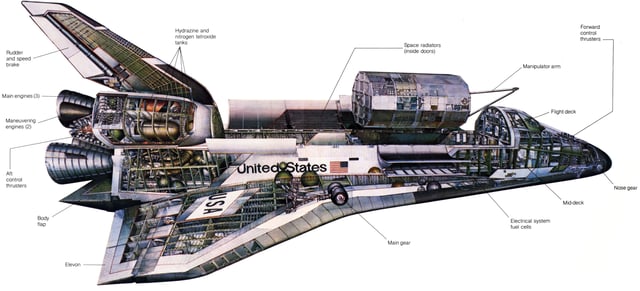
Space Shuttle orbiter illustration

Space Shuttle drawing
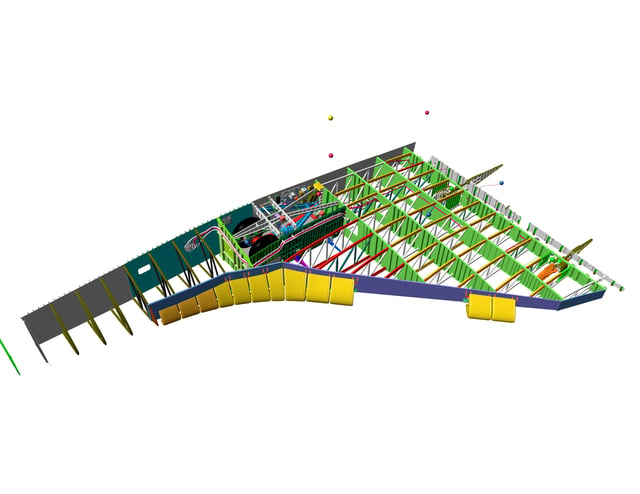
Space Shuttle wing cutaway
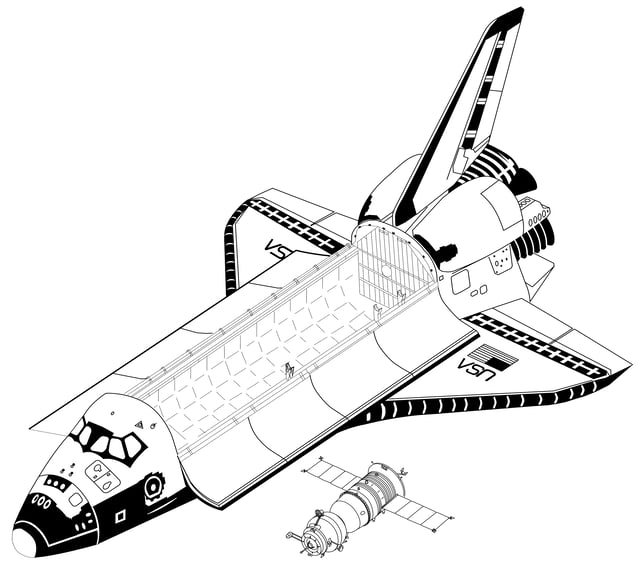
Space Shuttle Orbiter and Soyuz-TM (drawn to scale).
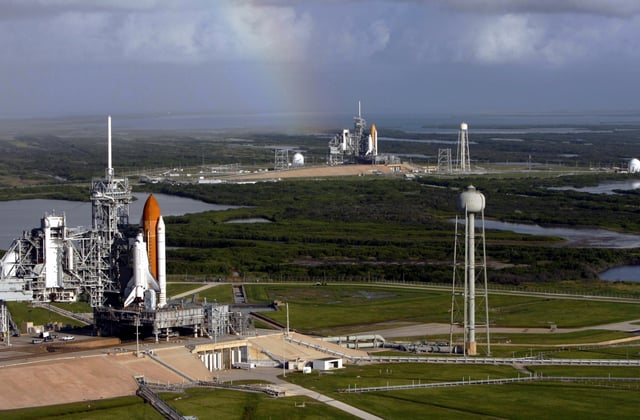
Atlantis and Endeavour on launch pads. This particular occasion is due to the final Hubble servicing mission, where the International Space Station is unreachable, which necessitates having a Shuttle on standby for a possible rescue mission.
Orbiter [23]Space%20Shuttle%3A%20The%20His]]forEndeavour, OV-105)
Length: 122.17 ft (37.237 m)
Wingspan: 78.06 ft (23.79 m)
Height: 56.58 ft (17.25 m)
Empty weight: 172,000 lb (78,000 kg)[62]
Gross liftoff weight (Orbiter only): 240,000 lb (110,000 kg)
Maximum landing weight: 230,000 lb (100,000 kg)
Payload to Landing (Return Payload): 32,000 lb (14,400 kg)[8]
Maximum payload: 55,250 lb (25,060 kg)
Payload to LEO 204 kilometers (110 nmi) @ 28.5° inclination: 27,500 kilograms (60,600 lb)
Payload to LEO (407 kilometers (220 nmi) @ 51.6° to ISS): 16,050 kilograms (35,380 lb)[63]
Payload to GTO: 8,390 lb (3,806 kg)
Payload to Polar Orbit: 28,000 lb (12,700 kg)
Note launch payloads modified by External Tank (ET) choice (ET, LWT, or SLWT)
Payload bay dimensions: 15 by 59 ft (4.6 by 18 m) (diameter by length)
Operational altitude: 100 to 520 nmi (190 to 960 km; 120 to 600 mi)
Speed: 7,743 m/s (27,870 km/h; 17,320 mph)
Crossrange: 1,085 nmi (2,009 km; 1,249 mi)
Main Stage (SSME with external tank) Engines: Three Rocketdyne Block II SSMEs, each with a sea level thrust of 393,800 lbf (1,752 kN) at 104% power Thrust (at liftoff, sea level, 104% power, all 3 engines): 1,181,400 lbf (5,255 kN) Specific impulse: 455 seconds (4.46 km/s) Burn time: 480 s Fuel: Liquid Hydrogen/Liquid Oxygen
Orbital Maneuvering System Engines: 2 OMS Engines Thrust: 53.4 kN (12,000 lbf) combined total vacuum thrust Specific impulse: 316 seconds (3.10 km/s) Burn time: 150–250 s typical burn; 1250 s deorbit burn Fuel: MMH/N2O4
Crew: Varies
External tank (for SLWT)
Length: 46.9 m (153.8 ft)
Diameter: 8.4 m (27.6 ft)
Propellant volume: 2,025 m3 (534,900 U.S. gal)
Empty weight: 26,535 kg (58,500 lb)
Gross liftoff weight (for tank): 756,000 kg (1,670,000 lb)
Solid Rocket Boosters
System Stack
Height: 56 m (180 ft)
Gross liftoff weight: 2,000,000 kg (4,400,000 lb)
Total liftoff thrust: 30,160 kN (6,780,000 lbf)
Mission profile
Launch preparation
All Space Shuttle missions were launched from Kennedy Space Center (KSC).
The weather criteria used for launch included, but were not limited to: precipitation, temperatures, cloud cover, lightning forecast, wind, and humidity.[66] The Shuttle was not launched under conditions where it could have been struck by lightning. Aircraft are often struck by lightning with no adverse effects because the electricity of the strike is dissipated through its conductive structure and the aircraft is not electrically grounded. Like most jet airliners, the Shuttle was mainly constructed of conductive aluminum, which would normally shield and protect the internal systems. However, upon liftoff the Shuttle sent out a long exhaust plume as it ascended, and this plume could have triggered lightning by providing a current path to ground. The NASA Anvil Rule for a Shuttle launch stated that an anvil cloud could not appear within a distance of 10 nautical miles (19 km).[67] The Shuttle Launch Weather Officer monitored conditions until the final decision to scrub a launch was announced. In addition, the weather conditions had to be acceptable at one of the Transatlantic Abort Landing sites (one of several Space Shuttle abort modes) to launch as well as the solid rocket booster recovery area.[66][68] While the Shuttle might have safely endured a lightning strike, a similar strike caused problems on Apollo 12, so for safety NASA chose not to launch the Shuttle if lightning was possible (NPR8715.5).
Historically, the Shuttle was not launched if its flight would run from December to January (a year-end rollover or YERO).
Its flight software, designed in the 1970s, was not designed for this, and would require the orbiter's computers be reset through a change of year, which could cause a glitch while in orbit.
In 2007, NASA engineers devised a solution so Shuttle flights could cross the year-end boundary.[69]
Launch
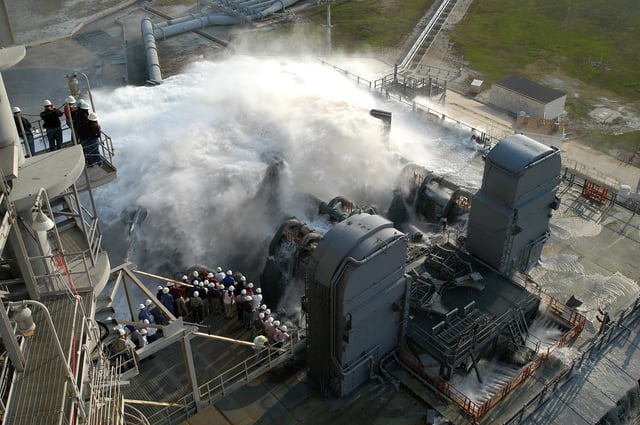
A test of the sound suppression system test in 2004.
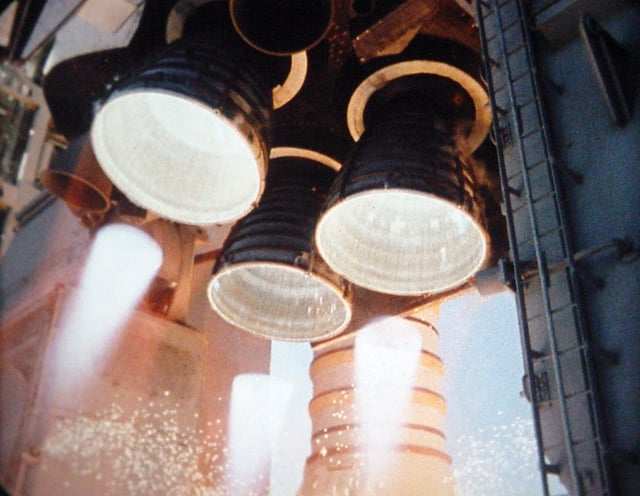
Space Shuttle Main Engine ignition
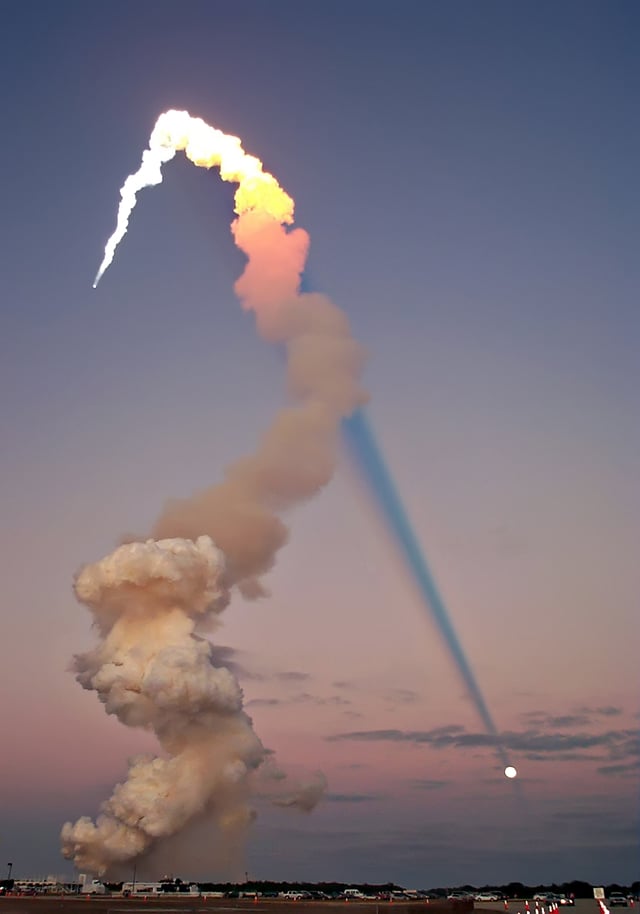
STS-98 launch in February 2001
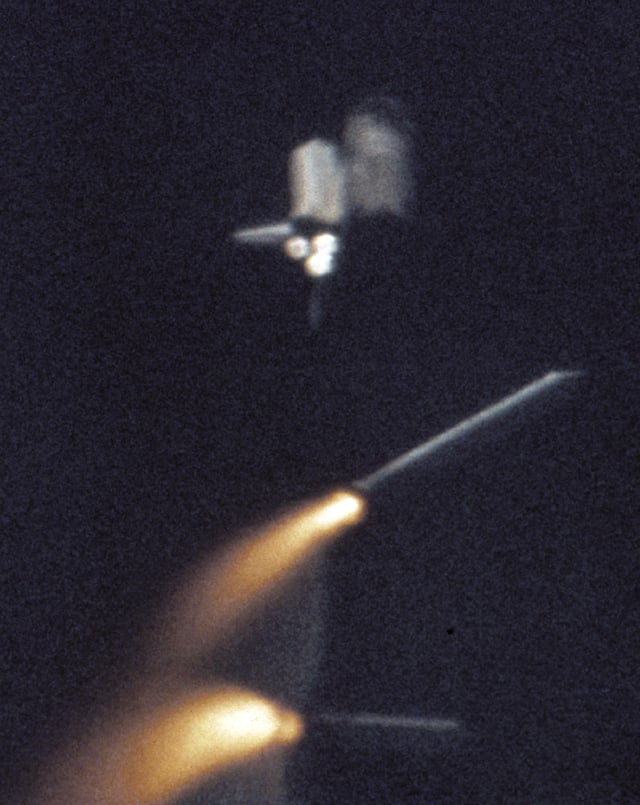
Solid Rocket Booster (SRB) separation during STS-1.
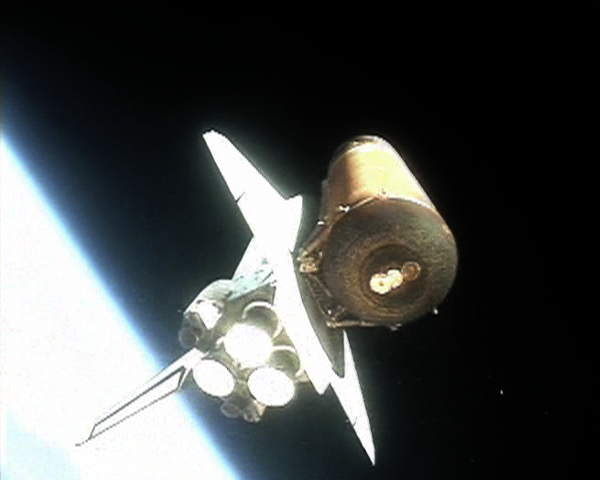
Discovery attached to the external tank immediately after solid rocket booster (SRB) separation
After the final hold in the countdown at T-minus 9 minutes, the Shuttle went through its final preparations for launch, and the countdown was automatically controlled by the Ground Launch Sequencer (GLS), software at the Launch Control Center, which stopped the count if it sensed a critical problem with any of the Shuttle's onboard systems.
The GLS handed off the count to the Shuttle's on-board computers at T minus 31 seconds, in a process called auto sequence start.
At T-minus 16 seconds, the massive sound suppression system (SPS) began to drench the Mobile Launcher Platform (MLP) and SRB trenches with 300,000 US gallons (1,100,000 L) of water to protect the Orbiter from damage by acoustical energy and rocket exhaust reflected from the flame trench and MLP during lift off.[70][72]
At T-minus 10 seconds, hydrogen igniters were activated under each engine bell to quell the stagnant gas inside the cones before ignition.
Failure to burn these gases could trip the onboard sensors and create the possibility of an overpressure and explosion of the vehicle during the firing phase.
The main engine turbopumps also began charging the combustion chambers with liquid hydrogen and liquid oxygen at this time.
The computers reciprocated this action by allowing the redundant computer systems to begin the firing phase.
The three main engines (SSMEs) started at T-6.6 seconds. The main engines ignited sequentially via the Shuttle's general purpose computers (GPCs) at 120 millisecond intervals. All three SSMEs were required to reach 90% rated thrust within three seconds, otherwise the onboard computers would initiate an RSLS abort. If all three engines indicated nominal performance by T-3 seconds, they were commanded to gimbal to liftoff configuration and the command would be issued to arm the SRBs for ignition at T-0.[73] Between T-6.6 seconds and T-3 seconds, while the SSMEs were firing but the SRBs were still bolted to the pad, the offset thrust caused the entire launch stack (boosters, tank and orbiter) to pitch down 650 mm (25.5 in) measured at the tip of the external tank. The three second delay after confirmation of SSME operation was to allow the stack to return to nearly vertical. At T-0 seconds, the 8 frangible nuts holding the SRBs to the pad were detonated, the SSMEs were commanded to 100% throttle, and the SRBs were ignited.[74][75] By T+0.23 seconds, the SRBs built up enough thrust for liftoff to commence, and reached maximum chamber pressure by T+0.6 seconds.[76] The Johnson Space Center's Mission Control Center assumed control of the flight once the SRBs had cleared the launch tower.
Shortly after liftoff, the Shuttle's main engines were throttled up to 104.5% and the vehicle began a combined roll, pitch and yaw maneuver that placed it onto the correct heading (azimuth) for the planned orbital inclination and in a heads down attitude with wings level.
The Shuttle flew upside down during the ascent phase.
This orientation allowed a trim angle of attack that was favorable for aerodynamic loads during the region of high dynamic pressure, resulting in a net positive load factor, as well as providing the flight crew with a view of the horizon as a visual reference.
The vehicle climbed in a progressively flattening arc, accelerating as the mass of the SRBs and main tank decreased.
To achieve low orbit requires much more horizontal than vertical acceleration.
This was not visually obvious, since the vehicle rose vertically and was out of sight for most of the horizontal acceleration.
The near circular orbital velocity at the 380 kilometers (236 mi) altitude of the International Space Station is 27,650 km/h (17,180 mph), roughly equivalent to Mach 23 at sea level.
As the International Space Station orbits at an inclination of 51.6 degrees, missions going there must set orbital inclination to the same value in order to rendezvous with the station.
Around 30 seconds into ascent, the SSMEs were throttled down—usually to 72%, though this varied—to reduce the maximum aerodynamic forces acting on the Shuttle at a point called Max Q. Additionally, the propellant grain design of the SRBs caused their thrust to drop by about 30% by 50 seconds into ascent. Once the Orbiter's guidance verified that Max Q would be within Shuttle structural limits, the main engines were throttled back up to 104.5%; this throttling down and back up was called the "thrust bucket". To maximize performance, the throttle level and timing of the thrust bucket was shaped to bring the Shuttle as close to aerodynamic limits as possible.[77]
At around T+126 seconds, pyrotechnic fasteners released the SRBs and small separation rockets pushed them laterally away from the vehicle. The SRBs parachuted back to the ocean to be reused. The Shuttle then began accelerating to orbit on the main engines. Acceleration at this point would typically fall to 0.9 g (8.829 m/s2, 28.97 ft/s2), and the vehicle would take on a somewhat nose-up angle to the horizon – it used the main engines to gain and then maintain altitude while it accelerated horizontally towards orbit. At about five and three-quarter minutes into ascent, the orbiter's direct communication links with the ground began to fade, at which point it rolled heads up to reroute its communication links to the Tracking and Data Relay Satellite system.
At about seven and a half minutes into ascent, the mass of the vehicle was low enough that the engines had to be throttled back to limit vehicle acceleration to 3 g (29.43 m/s2, 96.6 ft/s2). The Shuttle would maintain this acceleration for the next minute, and MECO occurred at about eight and a half minutes after launch.[78] The main engines were shut down before complete depletion of propellant, as running dry would have destroyed the engines. The oxygen supply was terminated before the hydrogen supply, as the SSMEs reacted unfavorably to other shutdown modes. (Liquid oxygen has a tendency to react violently, and supports combustion when it encounters hot engine metal.) A few seconds after MECO, the external tank was released by firing its two frangible nuts.[48][79]
At this point the Shuttle and external tank were on a slightly suborbital trajectory, coasting up towards apogee. Once at apogee, about half an hour after MECO, the Shuttle's Orbital Maneuvering System (OMS) engines were fired to raise its perigee and achieve orbit, while the external tank fell back into the atmosphere and burned up over the Indian Ocean or the Pacific Ocean depending on launch profile.[23] The sealing action of the tank plumbing and lack of pressure relief systems on the external tank helped it break up in the lower atmosphere. After the foam burned away during re-entry, the heat caused a pressure buildup in the remaining liquid oxygen and hydrogen until the tank exploded. This ensured that any pieces that fell back to Earth were small.
Ascent tracking
Contraves-Goerz Kineto Tracking Mount used to image the space Shuttle during launch ascent
The Shuttle was monitored throughout its ascent for short range tracking (10 seconds before liftoff through 57 seconds after), medium range (7 seconds before liftoff through 110 seconds after) and long range (7 seconds before liftoff through 165 seconds after).
Short range cameras included 22 16mm cameras on the Mobile Launch Platform and 8 16mm on the Fixed Service Structure, 4 high speed fixed cameras located on the perimeter of the launch complex plus an additional 42 fixed cameras with 16mm motion picture film.
Medium range cameras included remotely operated tracking cameras at the launch complex plus 6 sites along the immediate coast north and south of the launch pad, each with 800mm lens and high speed cameras running 100 frames per second.
These cameras ran for only 4–10 seconds due to limitations in the amount of film available.
Long range cameras included those mounted on the external tank, SRBs and orbiter itself which streamed live video back to the ground providing valuable information about any debris falling during ascent.
Long range tracking cameras with 400-inch film and 200-inch video lenses were operated by a photographer at Playalinda Beach as well as 9 other sites from 38 miles north at the Ponce Inlet to 23 miles south to Patrick Air Force Base (PAFB) and additional mobile optical tracking camera was stationed on Merritt Island during launches. A total of 10 HD cameras were used both for ascent information for engineers and broadcast feeds to networks such as NASA TV and HDNet. The number of cameras significantly increased and numerous existing cameras were upgraded at the recommendation of the Columbia Accident Investigation Board to provide better information about the debris during launch. Debris was also tracked using a pair of Weibel Continuous Pulse Doppler X-band radars, one on board the SRB recovery ship MV Liberty Star positioned north east of the launch pad and on a ship positioned south of the launch pad. Additionally, during the first 2 flights following the loss of Columbia and her crew, a pair of NASA WB-57 reconnaissance aircraft equipped with HD Video and Infrared flew at 60,000 feet (18,000 m) to provide additional views of the launch ascent.[80] Kennedy Space Center also invested nearly $3 million in improvements to the digital video analysis systems in support of debris tracking.[81]
In orbit
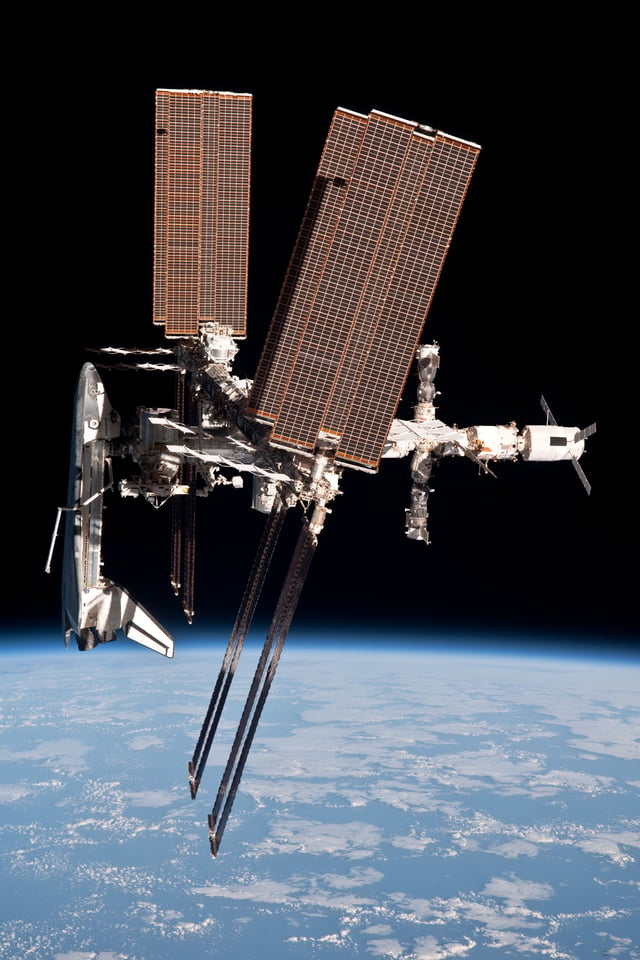
Endeavour docked at ISS
Once in orbit, the Shuttle usually flew at an altitude of 320 km (170 nmi), although the STS-82 mission reached 620 km (330 nmi).[82] In the 1980s and 1990s, many flights involved space science missions on the ESA Spacelab, or launching various types of satellites and science probes. By the 1990s and 2000s the focus shifted more to servicing the space station, with fewer satellite launches. Most missions involved staying in orbit several days to two weeks, although longer missions were possible with the Extended Duration Orbiter add-on or when attached to a space station. STS-80 was the longest at almost 17 days and 16 hours.
Re-entry and landing

Simulation of the outside of the Shuttle as it heats up to over 1,500 °C (2,730 °F) during re-entry.

Flight deck view of the Space Shuttle Discovery during STS-42 re-entry
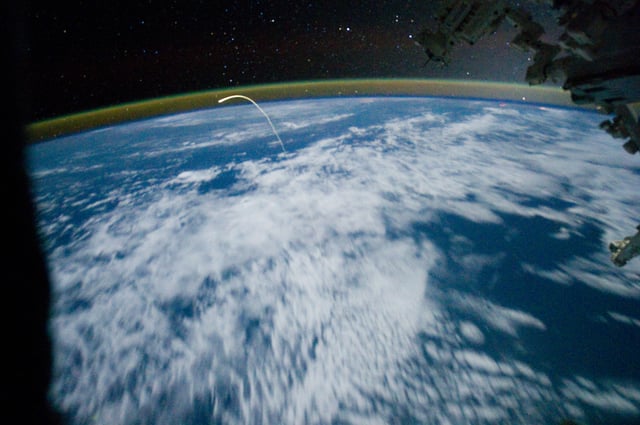
Glowing plasma trail from Space Shuttle Atlantis re-entry as seen from the Space Station
Almost the entire Space Shuttle re-entry procedure, except for lowering the landing gear and deploying the air data probes, was normally performed under computer control.
The re-entry could be flown entirely manually if an emergency arose.
The approach and landing phase could be controlled by the autopilot, but was usually hand flown.
The vehicle began re-entry by firing the Orbital maneuvering system engines, while flying upside down, backside first, in the opposite direction to orbital motion for approximately three minutes, which reduced the Shuttle's velocity by about 200 mph (322 km/h).[83] The resultant slowing of the Shuttle lowered its orbital perigee down into the upper atmosphere. The Shuttle then flipped over, by pushing its nose down (which was actually "up" relative to the Earth, because it was flying upside down). This OMS firing was done roughly halfway around the globe from the landing site.
The vehicle started encountering more significant air density in the lower thermosphere at about 400,000 ft (120 km), at around Mach 25 (30,626 km/h; 19,030 mph).
The vehicle was controlled by a combination of RCS thrusters and control surfaces, to fly at a 40-degree nose-up attitude, producing high drag, not only to slow it down to landing speed, but also to reduce reentry heating. As the vehicle encountered progressively denser air, it began a gradual transition from spacecraft to aircraft. In a straight line, its 40-degree nose-up attitude would cause the descent angle to flatten-out, or even rise. The vehicle accomplished aerobraking with a series of four steep S-shaped banking turns, each lasting several minutes, at up to 70 degrees of bank, while still maintaining the 40-degree angle of attack. In this way it dissipated speed sideways rather than upwards. This occurred during the 'hottest' phase of re-entry, when the heat-shield glowed red and the G-forces were at their highest. By the end of the last turn, the transition to aircraft was almost complete. The vehicle leveled its wings, lowered its nose into a shallow dive and began its approach to the landing site.
The orbiter's maximum glide ratio/lift-to-drag ratio varied considerably with speed, ranging from 1:1 at hypersonic speeds, 2:1 at supersonic speeds and reaching 4.5:1 at subsonic speeds during approach and landing.[84]
In the lower atmosphere, the orbiter flew much like a conventional glider, except for a much higher descent rate, over 9,800 ft/min (50 m/s).
At approximately Mach 3 (3,675 km/h; 2,284 mph), two air data probes, located on the left and right sides of the orbiter's forward lower fuselage, were deployed to sense air pressure related to the vehicle's movement in the atmosphere.
Final approach and landing phase

Atlantis landing at KSC after STS-122.
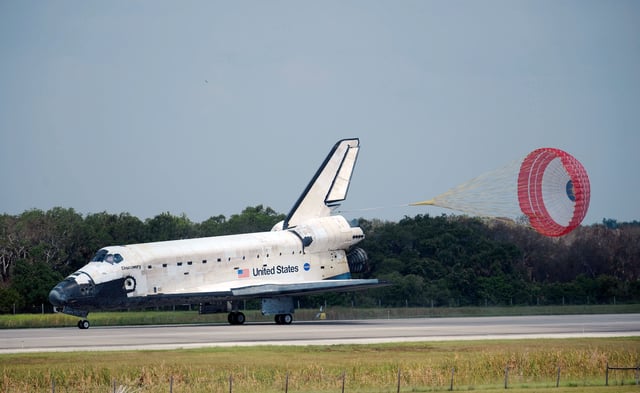
Discovery deploying its brake parachute after landing on STS-124.
When the approach and landing phase began, the orbiter was at a 3,000 m (9,800 ft) altitude, 12 km (7.5 mi) from the runway.
The pilots applied aerodynamic braking to help slow down the vehicle.
The orbiter's speed was reduced from 682 to 346 km/h (424 to 215 mph), approximately, at touch-down (compared to 260 km/h or 160 mph for a jet airliner).
The landing gear was deployed while the Orbiter was flying at 430 km/h (270 mph).
To assist the speed brakes, a 12 m (39 ft) drag chute was deployed either after main gear or nose gear touchdown (depending on selected chute deploy mode) at about 343 km/h (213 mph).
The chute was jettisoned once the orbiter slowed to 110 km/h (68.4 mph).
Landing sites
The primary Space Shuttle landing site was the Shuttle Landing Facility to be at Kennedy Space Center. In the event of unfavorable landing conditions, the Shuttle could delay its landing or land at an alternate location. The primary alternate was Edwards AFB, which was used for over 50 shuttle landings. Space Shuttle Columbia landed at the White Sands Space Harbor after STS-3, and required extensive post-processing after exposure to the gypsum-rich sand. Landings at alternate airfields required the Shuttle Carrier Aircraft to transport the orbiter back to Cape Canaveral.[85]
In addition to the pre-planned landing airfields, there were emergency landing sites to be used in different abort scenarios. Facilities on the east coast of the US were planned for East Coast Abort Landings, while several sites in Europe and Africa were planned in the event of a Transoceanic Abort Landing. The facilities were prepared with equipment and personnel in the event of an emergency shuttle landing, but were never used.[86][87][85]
Post-landing processing
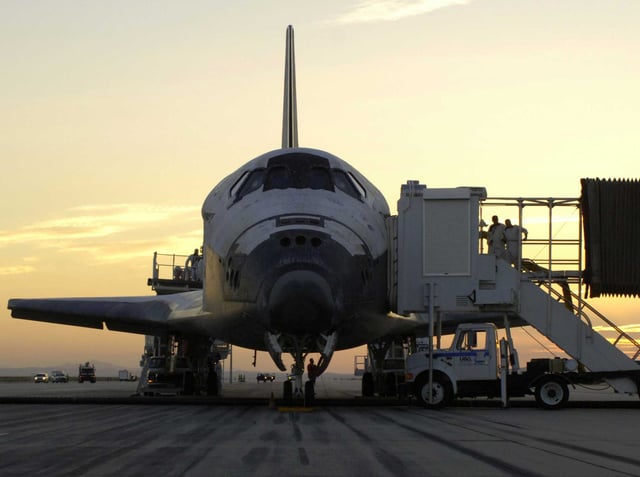
Discovery after landing on Earth for crew disembarkment
After landing, the vehicle stayed on the runway for several hours for the orbiter to cool.
Teams at the front and rear of the orbiter tested for presence of hydrogen, hydrazine, monomethylhydrazine, nitrogen tetroxide and ammonia (fuels and by-products of the reaction control system and the orbiter's three APUs). If hydrogen was detected, an emergency would be declared, the orbiter powered down and teams would evacuate the area. A convoy of 25 specially designed vehicles and 150 trained engineers and technicians approached the orbiter. Purge and vent lines were attached to remove toxic gases from fuel lines and the cargo bay about 45–60 minutes after landing. A flight surgeon boarded the orbiter for initial medical checks of the crew before disembarking. Once the crew left the orbiter, responsibility for the vehicle was handed from the Johnson Space Center back to the Kennedy Space Center.[88]
If the mission ended at Edwards Air Force Base in California, White Sands Space Harbor in New Mexico, or any of the runways the orbiter might use in an emergency, the orbiter was loaded atop the Shuttle Carrier Aircraft, a modified 747, for transport back to the Kennedy Space Center, landing at the Shuttle Landing Facility. Once at the Shuttle Landing Facility, the orbiter was then towed 2 miles (3.2 km) along a tow-way and access roads normally used by tour buses and KSC employees to the Orbiter Processing Facility where it began a months-long preparation process for the next mission.[88]
Fleet history
Flight timeline
Major events
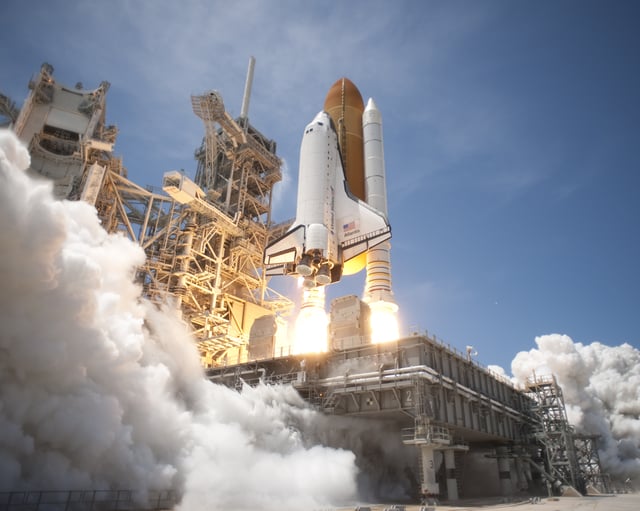
Atlantis lifts off from Launch Pad 39A at NASA's Kennedy Space Center in Florida on the STS-132 mission to the International Space Station at 2:20 pm EDT on May 14, 2010.
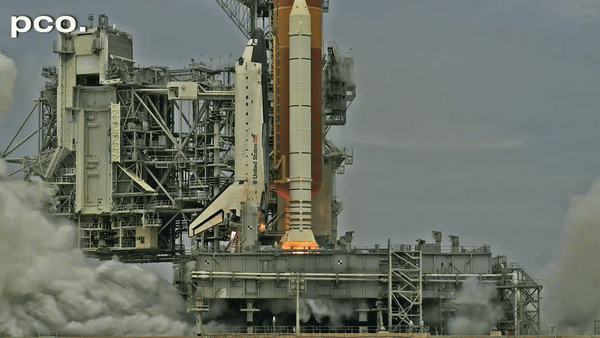
STS-135 last Space Shuttle liftoff in slow motion
Major events for the Space Shuttle orbiter fleet are listed below.
| Date | Orbiter | Major event / remarks |
|---|---|---|
| September 17, 1976 | Enterprise | Prototype Space ShuttleEnterprisewas rolled out of its assembly facility in Southern California and displayed before a crowd of several thousand people.[89] |
| February 18, 1977 | Enterprise | First flight; Attached toShuttle Carrier Aircraftthroughout flight. |
| August 12, 1977 | Enterprise | First free flight; Tailcone on; lakebed landing. |
| October 26, 1977 | Enterprise | FinalEnterprisefree flight; First landing on Edwards AFB concrete runway. |
| April 12, 1981 | Columbia | FirstColumbiaflight, first orbital test flight;STS-1 |
| November 11, 1982 | Columbia | First operational flight of the Space Shuttle, first mission to carry four astronauts;STS-5 |
| April 4, 1983 | Challenger | FirstChallengerflight;STS-6 |
| August 30, 1984 | Discovery | FirstDiscoveryflight;STS-41-D |
| October 3, 1985 | Atlantis | FirstAtlantisflight;STS-51-J |
| October 30, 1985 | Challenger | First and only crew of eight astronauts;STS-61-A |
| January 28, 1986 | Challenger | Loss of vehicle 73 seconds after launch;STS-51-L; all seven crew members died. |
| September 29, 1988 | Discovery | First post-Challenger mission;STS-26 |
| May 4, 1989 | Atlantis | The first Space Shuttle mission to launch an interplanetary probe,Magellan;STS-30 |
| April 24, 1990 | Discovery | Launch of theHubble Space Telescope;STS-31 |
| May 7, 1992 | Endeavour | FirstEndeavourflight;STS-49 |
| February 3, 1995 | Discovery | First rendezvous with the Russian space stationMir.First female shuttle pilot,Eileen Collins;STS-63 |
| November 19, 1996 | Columbia | Longest Shuttle mission at 17 days, 15 hours;STS-80 |
| December 4, 1998 | Endeavour | FirstISSmission;STS-88 |
| July 23, 1999 | Columbia | Launch of theChandra X-Ray Observatory.First mission commanded by a woman, Eileen Collins;STS-93 |
| February 1, 2003 | Columbia | Disintegrated during re-entry;STS-107; all seven crew members died. |
| July 25, 2005 | Discovery | First post-Columbia mission;STS-114 |
| February 24, 2011 | Discovery | LastDiscoveryflight;STS-133 |
| May 16, 2011 | Endeavour | LastEndeavourmission;STS-134[90][91] |
| July 8, 2011 | Atlantis | LastAtlantisflight and last Space Shuttle flight;STS-135 |
Disasters
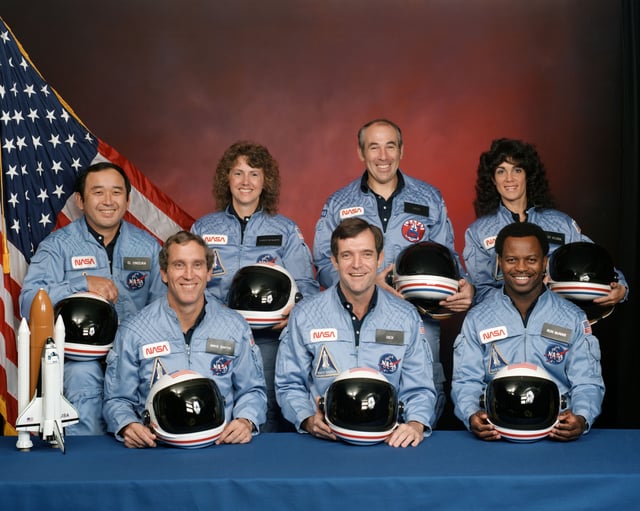
STS-51-L crew: (front row) Michael J. Smith, Dick Scobee, Ronald McNair; (back row) Ellison Onizuka, Christa McAuliffe, Gregory Jarvis, Judith Resnik
On January 28, 1986, Challenger disintegrated 73 seconds after launch due to the failure of the right SRB, killing all seven astronauts on board. The disaster was caused by low-temperature impairment of an O-ring, a mission critical seal used between segments of the SRB casing. Failure of the O-ring allowed hot combustion gases to escape from between the booster sections and burn through the adjacent external tank, leading to a sequence of events which caused the orbiter to disintegrate.[24] Repeated warnings from design engineers voicing concerns about the lack of evidence of the O-rings' safety when the temperature was below 53 °F (12 °C) had been ignored by NASA managers.[94]
On February 1, 2003, Columbia disintegrated during re-entry, killing its crew of seven, because of damage to the carbon-carbon leading edge of the wing caused during launch. Ground control engineers had made three separate requests for high-resolution images taken by the Department of Defense that would have provided an understanding of the extent of the damage, while NASA's chief thermal protection system (TPS) engineer requested that astronauts on board Columbia be allowed to leave the vehicle to inspect the damage. NASA managers intervened to stop the Department of Defense's assistance and refused the request for the spacewalk,[95] and thus the feasibility of scenarios for astronaut repair or rescue by Atlantis were not considered by NASA management at the time.[96][97]
Retirement

Atlantis orbiter's final welcome home, 2011
NASA retired the Space Shuttle in 2011, after 30 years of service.
The Shuttle was originally conceived of and presented to the public as a "Space Truck", which would, among other things, be used to build a United States space station in low earth orbit in the early 1990s. When the U.S. space station evolved into the International Space Station project, which suffered from long delays and design changes before it could be completed, the retirement of the Space Shuttle was delayed several times until 2011, serving at least 15 years longer than originally planned. Discovery was the first of NASA's three remaining operational Space Shuttles to be retired.[90]
The final Space Shuttle mission was originally scheduled for late 2010, but the program was later extended to July 2011 when Michael Suffredini of the ISS program said that one additional trip was needed in 2011 to deliver parts to the International Space Station.[99] The Shuttle's final mission consisted of just four astronauts—Christopher Ferguson (Commander), Douglas Hurley (Pilot), Sandra Magnus (Mission Specialist 1), and Rex Walheim (Mission Specialist 2);[100] they conducted the 135th and last space Shuttle mission on board Atlantis, which launched on July 8, 2011, and landed safely at the Kennedy Space Center on July 21, 2011, at 5:57 AM EDT (09:57 UTC).[101]
Distribution of orbiters and other hardware

Space Shuttle Program commemorative patch
NASA announced it would transfer orbiters to education institutions or museums at the conclusion of the Space Shuttle program.
Each museum or institution is responsible for covering the US$28.8 million cost of preparing and transporting each vehicle for display.
Twenty museums from across the country submitted proposals for receiving one of the retired orbiters.[102] NASA also made Space Shuttle thermal protection system tiles available to schools and universities for less than US$25 each.[103] About 7,000 tiles were available on a first-come, first-served basis, limited to one per institution.[103]
Orbiters on display
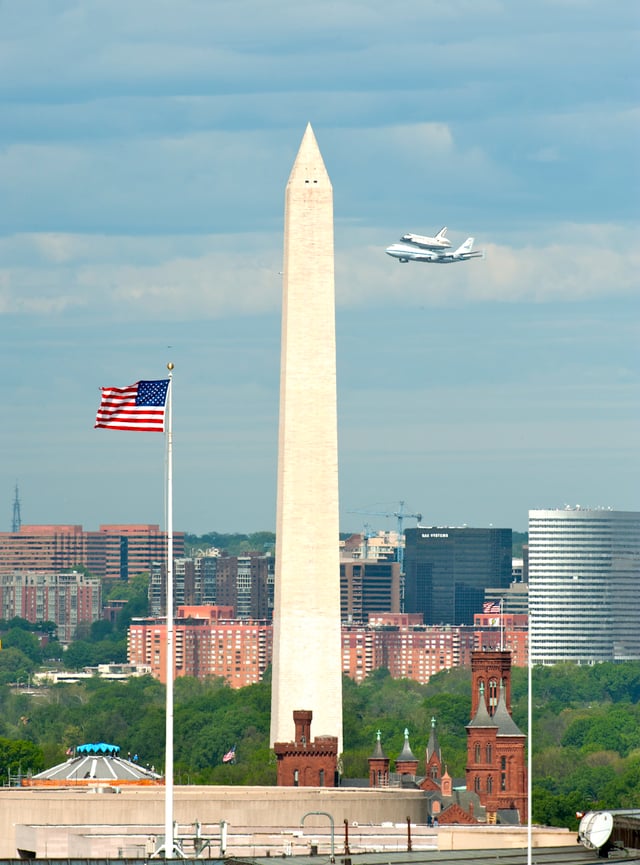
The Space Shuttle Discovery and the Washington Monument prior to landing at Dulles International Airport

Endeavour at Los Angeles International Airport
Atlantis is on display at the Kennedy Space Center Visitor Complex, near Cape Canaveral, Florida. It was delivered to the Visitor Complex on November 2, 2012.
Discovery was delivered to the Udvar-Hazy Center of the Smithsonian Institution's National Air and Space Museum in Chantilly, Virginia, near Washington, D.C. on April 19, 2012. On April 17, 2012, Discovery was flown atop a 747 Shuttle Carrier Aircraft escorted by a NASA T-38 Talon chase aircraft in a final farewell flight. The 747 and Discovery flew over Washington, D.C. and the metropolitan area around 10 am and arrived at Dulles around 11 am. The flyover and landing were widely covered on national news media.
Endeavour was delivered to the California Science Center in Los Angeles, California on October 14, 2012. It arrived at Los Angeles International Airport on September 21, 2012 escorted by two NASA F/A-18 Hornet chase aircraft, concluding a two-day, cross country journey atop the Shuttle Carrier Aircraft after stops at Ellington Field in Houston, Biggs Army Airfield in El Paso and the Dryden Flight Research Facility at Edwards Air Force Base, California.
Enterprise (atmospheric test orbiter) was on display at the National Air and Space Museum's Udvar-Hazy Center but was moved to New York City's Intrepid Sea-Air-Space Museum in mid-2012.[106]
In August 2011, the NASA Office of Inspector General (OIG) published a "Review of NASA's Selection of Display Locations for the Space Shuttle Orbiters"; the review had four main findings:[107]
"NASA's decisions regarding Orbiter placement were the result of an Agency-created process that emphasized above all other considerations locating the Orbiters in places where the most people would have the opportunity to view them";
"the Team made several errors during its evaluation process, including one that would have resulted in a numerical 'tie' among the Intrepid, the Kennedy Visitor Complex, and the National Museum of the U.S.
Air Force (Air Force Museum) in Dayton, Ohio";
there is "no evidence that the Team's recommendation or the Administrator's decision were tainted by political influence or any other improper consideration";
"some of the choices NASA made during the selection process – specifically, its decision to manage aspects of the selection as if it were a competitive procurement and to delay announcement of its placement decisions until April 2011 (more than 2 years after it first solicited information from interested entities)—may intensify challenges to the Agency and the selectees as they work to complete the process of placing the Orbiters in their new homes."
The NASA OIG had three recommendations, saying NASA should:[107]
"expeditiously review recipients' financial, logistical, and curatorial display plans to ensure they are feasible and consistent with the Agency's educational goals and processing and delivery schedules";
"ensure that recipient payments are closely coordinated with processing schedules, do not impede NASA's ability to efficiently prepare the Orbiters for museum display, and provide sufficient funds in advance of the work to be performed; and"
"work closely with the recipient organizations to minimize the possibility of delays in the delivery schedule that could increase the Agency's costs or impact other NASA missions and priorities."
In September 2011, the CEO and two board members of Seattle's Museum of Flight met with NASA Administrator Charles Bolden, pointing out "significant errors in deciding where to put its four retiring Space Shuttles"; the errors alleged include inaccurate information on Museum of Flight's attendance and international visitor statistics, as well as the readiness of the Intrepid Sea-Air-Space Museum's exhibit site.[108]
Orbiter replicas on display
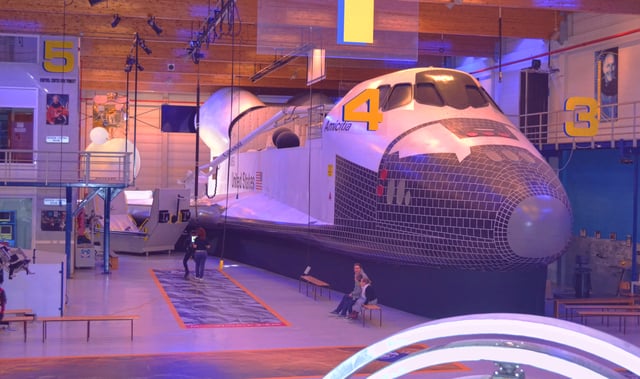
Life-size Replica of the NASA Space Shuttle at the Euro Space Center Belgium
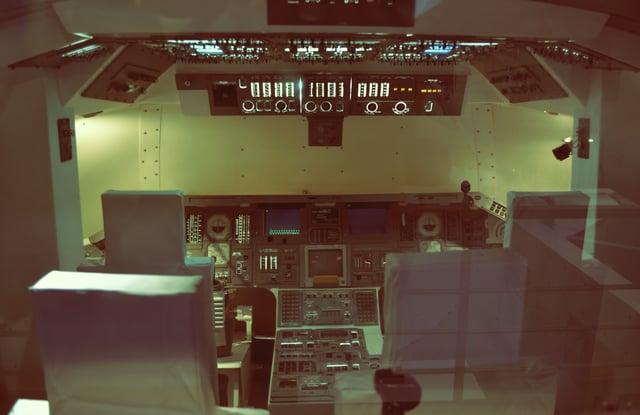
Replica of the space shuttle cockpit at the Euro Space Center In Belgium
Independence*]]* formerly known aslorer, is a full-scale, high-fidelity replica of the Space Shuttle. It was built by Guard-Lee in Apopka, Florida, installed at Kennedy Space Center Visitor Complex in 1993, and moved to Space Center Houston in 2012. It was built using schematics, blueprints and archival documents provided by NASA and by shuttle contractors such as Rockwell International. While many of the features on the replica are simulated, some parts, including the landing gear's Michelin tires, have been used in the Space Shuttle program.[109] The model is on display, mounted on top of the original Shuttle Carrier Aircraft (NASA 905) outside of the Visitors' Center.[110]
Pathfinder (honorary Orbiter Vehicle Designation: OV-098) is a Space Shuttle test simulator made of steel and wood. Constructed by NASA in 1977 as an unnamed test article, it was purchased in the early 1980s by the America-Japan Society, Inc. which had it refurbished, named it, and placed it on display in the Great Space Shuttle Exhibition in Tokyo. The mockup was later returned to the United States and placed on permanent display at the U.S. Space & Rocket Center in Huntsville, Alabama, in May 1988.
Hardware on display

STS conducted numerous experiments in space, such as this ionization experiment

Sprint cameras, tested by the Shuttle, may be used on ISS and other missions
One of the Crew Compartment Trainer (CCT) Flight and mid-deck training hardware was taken from the Johnson Space Center to the National Museum of the U.S. Air Force, another remains on display at JSC. The Full Fuselage Trainer (FFT), which includes the payload bay and aft section but no wings, went to the Museum of Flight in Seattle. The Mission Simulation and Training Facility's Shuttle Mission Simulator Fixed Base Simulator went to the Adler Planetarium in Chicago[111] but due to funding issues was later transferred to the Stafford Air & Space Museum in Weatherford OK;[112] the Motion Base Simulator went to the Texas A&M Aerospace Engineering Department in College Station, Texas, where it remains in storage awaiting funding or other disposition;[113] and the Guidance and Navigation Simulator (GNS) went to the Wings of Dreams Aviation Museum in Starke, Florida.[114] One of the Single System Trainers (SSTs) used in Shuttle astronaut training went to the Virginia Air and Space Center in Hampton, Virginia, the other two remain on display at the Johnson Space Center.[102]
In popular culture
Space Shuttles have been features of fiction and nonfiction, from children's movies to documentaries.
Early examples include the 1979 James Bond film, Moonraker, the 1982 Activision videogame Space Shuttle: A Journey into Space (1982) and G. Harry Stine's 1981 novel Shuttle Down. In the 1986 film SpaceCamp, Atlantis accidentally launches into space with a group of U.S. Space Camp participants as its crew. A Space Shuttle named Intrepid is featured in the 1989 film Moontrap
The 1998 film Armageddon portrays a combined crew of offshore oil rig workers and U.S. military staff who pilot two modified Shuttles to avert the destruction of Earth by an asteroid. Retired American test pilots visit a Russian satellite in the 2000 Clint Eastwood adventure film Space Cowboys. The 2004 Bollywood movie Swades, where a Space Shuttle is used to launch a special rainfall monitoring satellite, was filmed at Kennedy Space Center in the year after the Columbia disaster ]]he fictional Space Shuttle
On television, the 1996 drama The Cape portrays the lives of a group of NASA astronauts as they prepare for and fly Shuttle missions. Odyssey 5
The Space Shuttle has also been the subject of toys and models; for example, a large Lego Space Shuttle model was constructed by visitors at Kennedy Space Center,[115] and smaller models have been sold commercially as a standard "LegoLand" set. A 1980 pinball machine Space Shuttle was produced by Zaccaria and a 1984 pinball machine Space Shuttle: Pinball Adventure was produced by Williams and features a plastic Space Shuttle model among other artwork of astronauts on the play field. The Space Shuttle also appears in a number of flight simulator and space flight simulator games such as Microsoft Space Simulator, Orbiter, FlightGear, X-Plane and Space Shuttle Mission 2007. Several Transformers toys were modeled after the Space Shuttle.
The U.S. Postal Service has released several postage issues that depict the Space Shuttle.
The first such stamps were issued in 1981, and are on display at the National Postal Museum.[116]
See also
Spaceflight portal